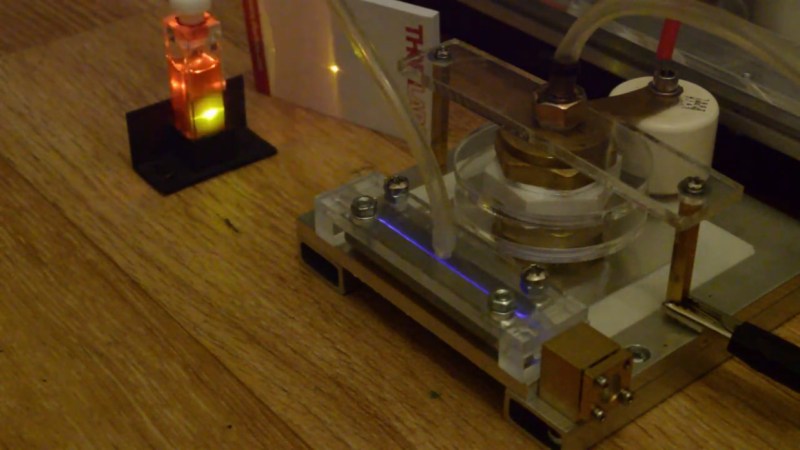If lasers are your hobby, you face a conundrum. There are so many off-the-shelf lasers that use so many different ways of amplifying and stimulating light that the whole thing can be downright — unstimulating. Keeping things fresh therefore requires rolling your own lasers, and these DIY nitrogen TEA and dye lasers seem like a fun way to go.
These devices are the work of [Les Wright], who takes us on a somewhat lengthy but really informative tour of transversely excited atmospheric (TEA) lasers. The idea with TEA lasers is that a gas, often carbon dioxide in commercial lasers but either air or pure nitrogen in this case, is excited by a high-voltage discharge across long parallel electrodes. TEA lasers are dead easy to make — we’ve covered them a few times — but as [Les] points out, that ease of construction leads to designs that are more ad hoc than engineered.
In the video below, [Les] presents three designs that are far more robust than the typical TEA laser. His lasers use capacitors made from aluminum foil with polyethylene sheets for dielectric, sometimes with the addition of beautiful “doorknob” ceramic caps too. A spark gap serves as a very fast switch to discharge high voltage across the laser channel, formed by two closely spaced aluminum hex bars. Both the spark gap and the laser channel can be filled with low-pressure nitrogen. [Les] demonstrates the power and the speed of his lasers, which can even excite laser emissions in a plain cuvette of rhodamine dye — no mirrors needed! Although eye protection is, of course.
These TEA lasers honestly look like a ton of fun to build and play with. You might not be laser welding or levitating stuff with them, but that’s hardly the point.
















Awesome. Now even tea can take an eye out.
The Brits know what’s up. There’s a reason they keep their army supplied with tea.
Englishmen have Tea, The Scottish have TEA.
First step to making an Infinite Improbability Drive!
Inspiring!
This is one of those videos that makes it look easy until you actually try it and realize the amount of difficult and frustrating experience and self-built peripheral equipment it takes to make it look just that easy.
For sure! That said, there is nothing particularly exotic in the build, except perhaps the doorknob caps. The Dye laser is another story, but you can build those from scrap too.
There was plans in a scientific america magazine many years ago to build a Nitrogen LASER – I had a go at it when I was in high school for a science fair project – unfortunately my lack of electronics ability stopped me from getting the high voltage PSU working which ended with the project been a “Simulated” LASER. Maybe when I retire Ill have the time and now I have the knowledge to get the thing running
Speaking of dielectrics, I wonder how cellphone screen protectors would stack up?
That’s gorilla glass with a bit of glue on the side at around 0.3 mm, which gets thinner when you dissolve the sticky bit off the other side.
Interesting. Never thought of that!
How powerful can a TEA LASER be? Would it be possible to build them with Victorian era tools and materials?
Over a Megawatt peak with avg powers of a few watts I believe.
There is a tongue in cheek discussion about Victorian Nitrogen Lasers here:
https://www.repairfaq.org/sam/lasercn2.htm